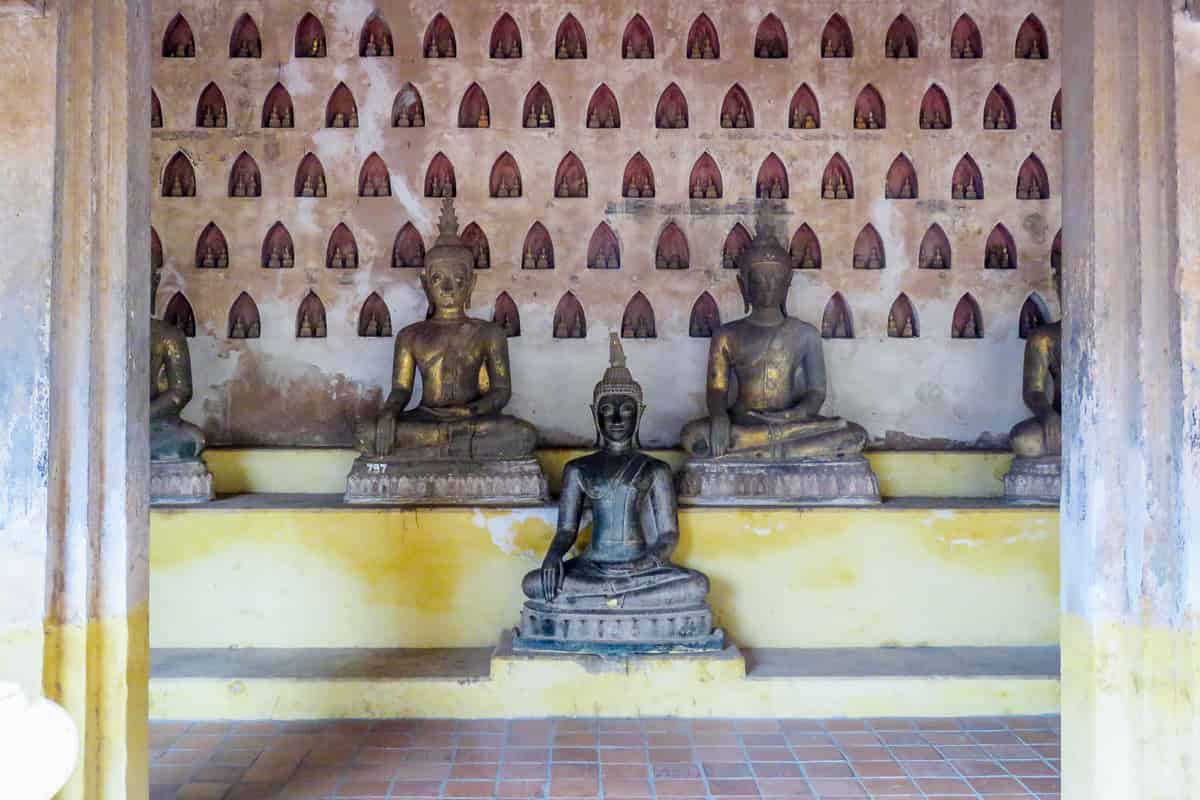Justine Tyerman travelled to Laos, famous for its many beautiful Buddhist temples.
I stood in the shade of the teak cloisters, grateful for some respite from the intense heat and humidity of the Laos sun. My eyes struggled to absorb the images surrounding me – 10,136 statues of Buddha dating back to the 16th century lined the walls of the courtyard that enclosed Wat Sisaket, a strikingly-beautiful temple and museum in Vientiane, the capital of Laos.
Wat Sisaket
Built in 1818 on orders of King Anouvong, it’s the only building to have survived the razing of the city by Siamese (Thai) invaders in 1828 making it the oldest temple in the city.
I was utterly mesmerised by the statues, especially the 8000 tiny miniatures placed in triangular niches in the walls. In front of them are 2000 larger seated Buddhas made of wood, stone and bronze, all with the same facial expression and their hands in the graceful Bhumisparsha mudra, ‘Calling the Earth to witness’ position. Some are standing with both hands by their sides.

On one side of the courtyard is a huge wooden trough or ‘Hang Hod’ in the shape of a naga or mythical serpent. During Laos New Year celebrations, perfumed water is poured through the trough and used for ceremonial cleaning of the Buddha images.
The central building or sanctuary, known as a ‘sim’, houses the impressive principal Buddha image seated on a high pedestal. Photos are forbidden inside the sim to protect the ancient murals from flashlights.
The temple has an ornate five-tiered roof decorated with golden naga finials. It’s a tranquil, cool place of reflection and quiet meditation.
Wat Phra Keo
Nearby Wat Phra Keo, Temple of the Emerald Buddha, has a fine collection of Lao and Khmer art. Built in 1565 as a chapel for the royal family, the temple was once home to the Emerald Buddha, hence the name, but the Thais stole the statue in 1778. It is now a museum famous for its wood and stone carvings and collection of Buddhas.
Wat Simuang
Wat Simuang is the most venerated temple in Vientiane, and considered the guardian of the spirit of the city. According to legend, if you circle the Angkorian-era pillar in the grounds three times and make a wish, it will come true.
Pha That Luang
Pha That Luang, or the Great Stupa, is dazzling. Constructed by King Setthathirat in the 16th century and restored in 1953, it is the most important Buddhist monument in Laos. The golden spire or stupa is 45m tall and believed to contain a relic of Buddha.
An impressive statue of the king stands in front of the stupa. In the grounds and nearby, there are a number of beautiful ornate temples and a magnificent golden reclining Buddha.
Exquisite temples and saffron-robed monks are quintessential images of Luang Prabang, the spiritual capital of Laos.
Wat Xieng Thong
Wat Xieng Thong, the most revered temple in Luang Prabang, was built in 1560 by King Setthathirat. A huge golden Buddha is the centrepiece of the ornately-decorated temple, surrounded by row-upon-row of smaller Buddha statues.
The walls of the temple are decorated with magnificent glass mosaics and ornate carvings and murals depicting Lao legends. The golden frontage of the temple is dazzling. So too is the mosaic Tree of Life on an outside wall.
There are over 20 structures in the grounds including a building to house the royal funeral barge pulled by a many-headed naga. A couple of friendly young monks were happy to pose in front of the temple. Laos is one of few places in the world where travellers can take photos of local people without having to pay a fee.
Wat Visoun
Wat Visoun, the oldest temple in Luang Prabang, dates back to 1513 and the reign of King Wisunarat (Visoun). Once home to the Prabang Buddhas, the temple was entirely rebuilt in 1887 after being destroyed by the invading Black Flags from Southern China.
It’s famous for the ‘Watermelon Stupa’ in the courtyard. It represents a lotus flower but is nicknamed watermelon because of its shape.
Wat Mai
We also visited Wat Mai, a temple renowned for its golden bas-relief, Wat Aham, which was first built in the 1500s, and Wat That where the ashes of King Sisavangvong are kept inside the large central stupa.
Every morning before sunrise, a time-honoured ritual takes place. Hundreds of monks from the temples walk along the streets of Luang Prabang receiving alms. Those giving alms are mainly women who sit in groups on the footpath with their bamboo baskets of sticky rice and other food.
The monks chant blessings to the alms-givers as they walk by with their lidded containers for the food. Aged from eight years to quite elderly, the barefoot, shaven-headed monks are a colourful sight in their bright orange robes.
About 80 percent of Lao males become monks at some point in their lives. They receive free education, accommodation, food and transport so a period of monkhood is especially common among rural communities where families tend to be larger and less able to afford schooling.
Factbox
Justine Tyerman travelled with Innovative Travel, a Christchurch-based boutique tour operator with 27 years’ experience offering travellers the opportunity to explore historically and culturally unique destinations worldwide that provide a challenge but with the security of a peace-of-mind 24/7 wrap-around service.
Travel Companions’ Club creating new horizons for social travellers: www.travelcompanions.club
Getting there:
Singapore Airlines flies from Auckland to Singapore daily, from Wellington four times weekly, and from Christchurch daily. Singapore Airlines has a code-share agreement with Swiss International Airlines (SWISS).
SilkAir flies from Singapore to Vientiane and Luang Prabang three times weekly.
Lao Airlines flies from Vientiane to Xieng Khuang.
Accommodation:
Crowne Plaza, Vientiane
Vansana Plain of Jars Hotel, Phonsavan
Parasol Blanc, Luang Prabang